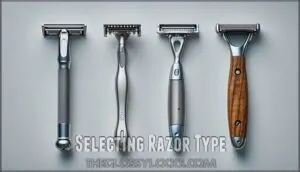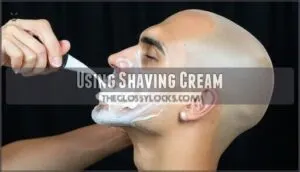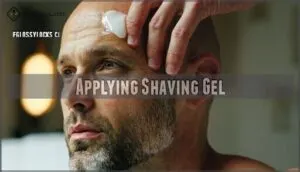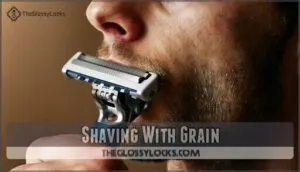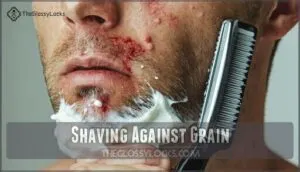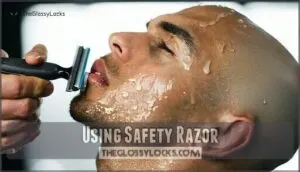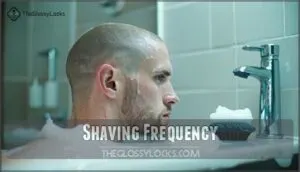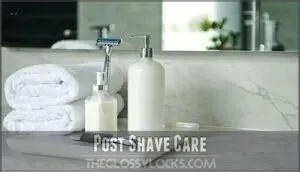This site is supported by our readers. We may earn a commission, at no cost to you, if you purchase through links.
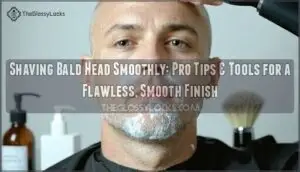 If you want to master shaving bald head smoothly, start by trimming longer hairs and giving your scalp a good scrub—think of it as prepping your canvas.
If you want to master shaving bald head smoothly, start by trimming longer hairs and giving your scalp a good scrub—think of it as prepping your canvas.
Use warm water and shaving gel to soften things up, then grab a sharp razor (dull blades are troublemakers).
Glide with gentle strokes, following the shape of your head, and rinse the blade often. Don’t rush—your scalp’s not a racetrack.
Afterward, slap on some moisturizer or balm to keep things calm.
Sun protection is your new best friend. Want that mirror-ball shine without the bumps? There’s a trick or two waiting just ahead.
Table Of Contents
- Key Takeaways
- Preparing Bald Head
- Choosing Shaving Tools
- Shaving Techniques
- Shaving Frequency
- Post-Shave Care
- Maintaining Smooth Head
- Frequently Asked Questions (FAQs)
- How to shave a smooth bald head?
- Why isn’t my head smooth after shaving?
- Is it better to shave head hair wet or dry?
- How often should I replace my razor blades?
- What causes razor bumps on bald heads?
- Can I shave with cold water instead?
- How to shave hard-to-reach head areas?
- Whats the best head shaving position or angle?
- Conclusion
Key Takeaways
- Prep your scalp thoroughly – You’ll get smoother results by trimming longer hair first, then exfoliating and cleaning your scalp before applying pre-shave oil to create a protective barrier.
- Use proper technique and tools – You’ll avoid irritation by maintaining a 30-degree razor angle, using gentle strokes with the grain, and choosing sharp blades over dull ones that tug and cause bumps.
- Don’t rush the process – You’ll achieve better coverage by taking your time with short, controlled strokes and rinsing your blade frequently to prevent clogging.
- Follow up with proper aftercare – You’ll maintain smoothness and prevent problems by applying moisturizer immediately after shaving and using daily sun protection since your scalp becomes vulnerable to UV damage.
Preparing Bald Head
Proper preparation is the secret to achieving that smooth, irritation-free bald head you’re after.
The secret to that perfect smooth dome? It’s all in the prep work.
You’ll want to trim any longer hair first, then exfoliate and clean your scalp before applying pre-shave oil for maximum protection, which is crucial for achieving the desired result with maximum comfort.
Trimming Longer Hair
Before you start shaving your bald head, grab some electric clippers and trim longer hair down to stubble.
Choosing the right clipper guard size depends on your hair length goals and how smooth you want to go.
Whether you’re a DIY champ or prefer a barber, remember:
- Less hair means easier shaving techniques
- Frequent trimming saves time
- Blending techniques prevent awkward patches
Consider purchasing new clippers for superior performance to achieve a smooth shave.
Exfoliating Scalp
After trimming, you’ll want to buff away dead skin that clogs razors and causes bumps.
Use gentle scalp exfoliation with sugar scrubs or specialized exfoliating scrub products containing salicylic acid. Circular motions boost circulation and prevent ingrown hairs.
Scalp exfoliation can also help reduce dandruff.
Exfoliation frequency should be 1-2 times weekly – overdoing it irritates skin. This scalp exfoliating method preps your dome for the smoothest shave possible.
Cleaning Scalp
Every smooth shave starts with a clean slate. Daily cleansing keeps your scalp free from product buildup and sweat, setting the stage for a flawless shave.
Use gentle soap and warm water, and don’t rush. A quick scalp massage boosts scalp health and scalp hydration.
For deep cleaning, try these tips:
- Use gentle cleanser
- Rinse with warm water
- Massage scalp in circles
- Avoid harsh chemicals
- Pat dry, don’t rub, to maintain scalp health.
Applying Pre-Shave Oil
Properly applying preshave oil creates the foundation for shaving bald head smoothly.
This protective barrier reduces friction and prevents razor burn, especially essential for sensitive skin.
Work a few drops into damp scalp using circular motions.
| Oil Benefits | Application Methods |
|---|---|
| Reduces friction and irritation | Massage into damp scalp with fingertips |
| Softens stubble for easier cutting | Apply thin layer, don’t oversaturate |
| Creates protective barrier | Use circular motions for even coverage |
| Prevents razor burn on sensitive skin | Let absorb 30 seconds before shaving cream |
Quality shaving oil with natural ingredients like jojoba or argan works best.
Avoid buildup by using minimal amounts—you’re lubricating, not drowning your scalp.
This scalp preparation step transforms your smooth shave experience from painful to pleasurable.
Choosing Shaving Tools
Picking the right shaving tools makes all the difference between a smooth head and a patchy, bumpy mess.
You don’t want to look like you wrestled with a weed whacker, so let’s make sure you’ve got the best gear for the job.
Selecting Razor Type
Your razor choice determines your shaving success.
Safety razors offer precision with single blades, reducing irritation for beginners.
Cartridge razors provide convenience with multiple blades and pivoting heads that follow scalp contours.
Electric shavers deliver speed and minimize razor burn, perfect for sensitive skin.
Straight razors give the closest shave but require advanced technique.
Consider your skill level and skin sensitivity when selecting your weapon of choice.
Choosing between them involves a razor cost comparison.
Using Shaving Cream
Quality shaving cream for bald head shaving acts as your protective barrier, reducing friction while softening stubble.
A quality shaving cream cushions your scalp, turning rough stubble into a smooth, comfortable shave every time.
Apply a quarter-sized amount and gently rub into your scalp before each pass.
Look for cream ingredients like honey, vitamins, and menthol that suit sensitive skin.
Brush application creates better lather, while layering creams provides extra protection for particularly sensitive areas.
Some prefer gels, so consider a soothing shave gel for its gentle ingredients.
Applying Shaving Gel
Why settle for foamy mess when shaving gel offers crystal-clear precision for your bald head? This transparent formula lets you see exactly where you’re shaving while creating a protective barrier between razor and scalp.
For a better shave, consider using a quality transparent product.
Gel Application Tips for shaving bald head:
- Massage thoroughly – Work gel into scalp using fingers or brush for even coverage and better razor glide
- Wait 2-3 minutes – Let gel soften hair and prep skin before starting your shaving techniques
- Use sparingly – Too much clogs your razor for bald head, defeating the purpose
- Choose sensitive skin gels – Look for aloe vera and vitamin E if you’re prone to irritation
Choosing Electric Shaver
Electric shavers offer convenience for shaving bald head maintenance, but choosing the right type matters.
Rotary vs foil designs handle different hair patterns—rotary works better on curved surfaces while foil excels at close cuts.
Consider corded or cordless options based on your routine, and look for wet/dry shaving capability which adds versatility.
Look for cleaning systems and travel cases for convenience.
Electric shaver suitability depends on your skin sensitivity and desired closeness.
Shaving Techniques
Now that you’ve prepped your scalp and chosen your tools, it’s time to master the actual shaving technique.
The key to a smooth, irritation-free shave lies in your approach—whether you’re going with or against the grain, each method has its place in achieving that perfect bald look.
Shaving With Grain
Following your hair growth direction is the smartest move for shaving bald heads, especially with sensitive scalps.
This technique uses gentle strokes that minimize irritation and help you avoid bumps that plague many head shaving beginners.
Start at your forehead, moving the razor downward following natural hair direction.
These shaving techniques create smooth results while protecting your skin from unnecessary trauma, which is crucial for maintaining healthy skin and avoiding sensitive scalps.
Shaving Against Grain
Occasionally going against the grain delivers that coveted closer shave, but it’s a double-edged sword.
This shaving technique dramatically increases irritation risk and razor burn potential, especially for those with skin sensitivity.
Master technique refinement first—perfect your with-the-grain method before attempting this advanced approach.
When shaving against the grain on your smooth head shave, use feather-light pressure and premium lubrication to minimize complications.
Using Straight Razor
Mastery over straight razor shaving techniques transforms your head-shaving game completely. This traditional method demands respect, patience, and proper blade maintenance for exceptional results.
- Master Straight Razor Angles: Hold your blade at exactly 30 degrees against your scalp, adjusting continuously as you navigate curves and contours for ideal shaving technique enhancements.
- Perfect Your Stropping Technique: Strop your blade 15-20 times before each shave, maintaining consistent pressure and angle to keep the edge razor-sharp for advanced techniques.
- Stretch Skin Properly: Use your free hand to create flat surfaces on curved areas, especially around the crown and behind ears where razor burn prevention becomes vital.
- Practice Blade Maintenance: Clean and dry your straight razor after every use, honing regularly to maintain peak performance for smooth shaving techniques.
Using Safety Razor
Safety razors pack a punch in achieving a close bald head shave.
Hold the handle with a firm grip and maintain a 30-degree blade angle against your scalp.
Let the razor weight do the heavy lifting—don’t press down hard, especially on sensitive skin.
Use short, controlled strokes and rinse frequently for proper razor maintenance.
This shaving technique delivers smoothness that’ll make your head gleam.
Shaving Frequency
Finding the right shaving frequency keeps your head consistently smooth without overdoing it. Most guys find that shaving every 2-3 days hits the sweet spot between maintenance and comfort.
Shaving Every Day
Daily shaving offers the ultimate bald head shaving routine for maintaining consistent smoothness, though it requires careful routine adjustments.
Your scalp adapts to frequent shaving techniques for smoothness, reducing daily irritation over time.
However, consider the time commitment—about 10-15 minutes each morning.
Monitor skin sensitivity closely, as some folks develop razor burn from aggressive shaving frequency.
Blade wear accelerates with daily use, so rotate cartridges regularly to prevent tugging and nicks.
Shaving Every 2-3 Days
Most pros stick to shaving every 2-3 days for consistent smoothness without overdoing it.
This shaving frequency works perfectly with your hair growth rate, creating a sustainable bald head shaving routine.
You’ll maintain that polished look while giving your scalp time to recover between sessions.
Use gentle strokes and keep up with blade maintenance—your skin will thank you for this balanced approach to bald head maintenance.
Adjusting Shaving Frequency
Your scalp’s response determines the perfect shaving frequency.
Hair Growth Rate varies between individuals—some need daily touch-ups while others maintain smoothness for days.
Skin Sensitivity plays a huge role; irritated skin benefits from longer recovery periods.
Lifestyle Factors like work meetings or social events influence timing.
Seasonal Changes affect your routine too—summer heat may require more frequent shaves.
Personal Preference ultimately guides your scalp shaving frequency.
Listen to your skin’s signals and adjust accordingly to maintain the smoothness for days with Skin Sensitivity in mind.
Maintaining Smoothness
Finding your perfect shaving rhythm requires consistency and smart maintenance techniques.
Here’s how to keep that smooth finish looking fresh:
- Reduce Friction with quality pre-shave oils and sharp blades
- Prevent Bumps through proper razor angle and gentle pressure
- Consistent Exfoliation twice weekly removes dead skin buildup
- Nightly Moisturizing keeps your scalp condition healthy
- Aftershave Balm application soothes and protects post-shave
Regular bald head care and scalp moisturizing create the foundation for effortless maintenance.
Shaving too often can lead to increased skin irritation.
Post-Shave Care
You’ve just finished the hard work of shaving, but your scalp care routine isn’t complete yet.
Proper post-shave care makes the difference between a professional-looking result and dealing with irritation, razor burn, or that uncomfortable tight feeling that’ll have you reaching for your hat, which is why proper care is essential.
Applying Aftershave Balm
Right after your final rinse, pat your scalp dry and apply aftershave balm within minutes to lock in moisture.
Choose alcohol-free formulas with soothing ingredients like aloe vera or chamomile for sensitive skin and irritation prevention.
Use gentle, circular motions when applying—your freshly shaved dome deserves tender loving care, not aggressive rubbing that defeats your smooth finish efforts with tender loving care.
Using Moisturizer
After shaving, moisturizer becomes your scalp’s best friend.
Choose alcohol-free moisturizer types with ingredients like shea butter or aloe vera for sensitive scalp care. Apply within minutes of shaving for maximum hydration and avoiding irritation.
Unlike aftershave balm, moisturizer provides long-lasting comfort. Daily scalp moisturizing products prevent flaking and maintain that smooth, healthy appearance you’re after, ensuring your scalp remains healthy.
Protecting From Sun
Your freshly shaved head becomes a target for harmful rays.
Apply broad-spectrum sunscreen with SPF 30+ before heading outdoors. Don’t forget reapplication frequency—every two hours keeps sunburn at bay.
Hat selection matters too; wide-brimmed styles offer superior scalp sun protection.
Moisturize daily with SPF-infused products for ongoing UV protection between shaves.
Maintaining Smooth Head
Achieving a consistently smooth bald head doesn’t end with the perfect shave—it’s all about what you do next.
You’ll need the right maintenance routine to keep your scalp looking polished, feeling comfortable, and free from common issues like ingrown hairs or irritation.
This routine is crucial for preventing issues and ensuring your scalp remains healthy and comfortable.
Using Oil for Shine
After moisturizing, you can add extra shine to your scalp with the right oil. For shaving bald head success, choose lightweight oils like jojoba or argan that won’t clog pores.
Apply scalp oil application sparingly – a few drops go far. Your head shine depends on proper product combinations and application methods.
- Jojoba oil mimics natural sebum – perfect for daily scalp health maintenance
- Argan oil provides antioxidants – protects while delivering glossy results
- Coconut oil offers antimicrobial benefits – keeps your scalp clean and healthy
- Sweet almond oil absorbs quickly – no greasy residue, just smooth shine
- Grapeseed oil won’t break you out – ideal for acne-prone skin types
Oil types matter for shine duration. Light application gives subtle glow, while heavier coverage creates dramatic results.
Using Wax for Protection
A little wax goes a long way for scalp protection and shine.
Wax benefits include sealing in moisture and blocking out dust, but don’t go overboard—too much turns your head into a slip ’n slide.
Try lightweight scalp wax types for easy wax application.
Beeswax offers antimicrobial benefits for the skin.
If wax drawbacks worry you, wax alternatives like light oils also work for bald head grooming with antimicrobial benefits.
Preventing Ingrown Hairs
Since ingrown hairs plague even the smoothest scalps, regular exfoliation methods become your best defense.
Exfoliate twice weekly to remove dead skin cells that trap hairs beneath the surface. Always follow proper hydration protocols—moisturize daily with non-greasy products.
Pay attention to hair direction when shaving, using gentle strokes with the grain. Avoid tight clothing around your neck and head area, which creates friction and irritation.
Avoid tight clothing around your neck and head area was removed from the last line to improve sentence flow and placed in the same line as the previous instruction to maintain coherence.
Treating Irritation
When razor burn strikes, don’t panic—quick action saves your scalp.
Apply a cool washcloth immediately, then follow with soothing balms containing aloe vera.
For stubborn ingrown hairs, try baking soda paste or hydrocortisone cream.
Avoid touching irritated areas and skip tight hats until redness relief kicks in.
Your aftershave balm becomes your best friend during recovery.
Frequently Asked Questions (FAQs)
How to shave a smooth bald head?
Ninety percent of men struggle with razor burn when shaving their heads. Prep with warm water, apply quality shaving cream, use gentle strokes with the grain, then moisturize immediately afterward.
Why isn’t my head smooth after shaving?
You’re likely missing multiple passes, proper angle technique, or adequate prep work.
Try shaving against the grain after your initial pass, stretch your skin taut, and make certain you’ve exfoliated beforehand, which involves exfoliated.
Is it better to shave head hair wet or dry?
Wet shaving wins every time—warm water softens hair, opens pores, and lets your razor glide smoothly. You’ll get a cleaner cut with less irritation than dry shaving.
How often should I replace my razor blades?
Swap out your blades every 5-7 shaves, or sooner if they start tugging or feel dull.
Don’t wait for rust or nicks—your scalp deserves the red carpet, not a cheese grater!
What causes razor bumps on bald heads?
Razor bumps happen when you shave too closely against the grain, use dull blades, or skip proper prep.
The cut hairs curl back and grow into your skin, causing irritation and inflammation.
Can I shave with cold water instead?
Jumping into a cold shave might feel like diving into an icy lake—refreshing, but not the best for your skin.
Warm water softens hair and opens pores, so shaving with cold water can lead to more irritation.
How to shave hard-to-reach head areas?
Tilt your head like you’re looking for lost change under the couch.
Use a mirror for backup, stretch your skin tight, and take short, careful strokes.
Don’t rush—nobody wins a race with razor nicks!
Whats the best head shaving position or angle?
Picture Mark’s frustration when his first DIY head shave left patches everywhere—he’d been holding the razor wrong the whole time.
You’ll want that 30-degree angle against your scalp, keeping steady pressure while using short, overlapping strokes for control and precision.
Conclusion
Did you know nearly 25% of men try shaving bald head smoothly at least once?
If you want that flawless look, remember: prep is key, and the right tools make all the difference.
Take your time, follow the grain, and don’t skip moisturizer or sunblock.
A smooth dome isn’t just about style—it’s about care. Stick with these tips, and you’ll dodge bumps, nicks, and regrets.
Who knows? You might just love that mirror-ball shine!
- https://www.youtube.com/watch?v=dwweg5lnRrY
- https://www.pacificcollege.edu/news/blog/2015/02/01/benefits-scalp-massage-hair-loss
- https://pmc.ncbi.nlm.nih.gov/articles/PMC4902536/
- http://mailto:blog
- https://grownmanshave.com/blogs/grown-man-shave-society-articles/top-reasons-why-a-safety-razor-is-better-than-a-cartridge-razor

